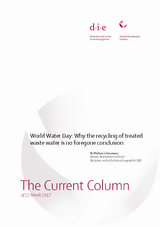World Water Day: Why the recycling of treated waste water is no foregone conclusion
Scheumann, WaltinaThe Current Column (2017)
German Development Institute / Deutsches Institut für Entwicklungspolitik (DIE) (The Current Column of 22 March 2017)
In many countries, municipal waste water is used for agricultural purposes, but it is rarely treated first. For instance, in Pakistan, farmers in the Lahore and Faisalabad districts use waste water to irrigate vegetables. This poses considerable health risks with regard to the consumption of this produce. The World Water Development Report is compiled under the oversight of UNESCO and published annually on World Water Day. The 2017 report deals with the issue of treated waste water. In theory, we could kill two birds with one stone here by improving sanitation and health care provision on the one hand and reducing competition for limited supplies of fresh water in water-poor regions on the other. However, this would require a paradigm shift, something also called for in the 2017 World Water Development Report. The focus is no longer on the purification and disposal of waste water, but rather on reuse, recycling and resource recovery. Despite the clear benefits it offers, the reuse of treated waste water is no foregone conclusion. Experience from a number of countries shows why. Low connection rates In India, just ten percent of the total waste water produced is treated and only around one third of urban households are connected to the sewage system. At the same time, we are seeing explosive growth in the number of new residential areas, planned and unplanned, as urbanisation proceeds apace. This means that there are an increasing number of households to be connected to the system. Available and affordable land on which to build large sewage treatment plants and large piping systems is in short supply. We need to use alternative technology instead of large conventional treatment plants with sunken sewers, as such plants are infeasible in coastal cities, for instance, due to their high groundwater tables. A lack of financial resources on the part of municipalities, high land prices and a preference for large conventional works present an obstacle to high connection rates and, by extension, to the reuse of treated waste water. Almost 60 per cent of Brazil’s urban population (98 million people) are connected to sewage systems. With 40 per cent of waste water and 70 per cent of collected waste water treated on average, reuse could be practiced but is not. In many cases, insufficient financial resources are not the only issue. Small municipalities lack the expertise needed to plan and operate the plants. Waste water charges are also based on household water consumption. As such, they are set too low, meaning sewage treatment utilities are unable to recover their costs. Jordan sees success with local plants Jordan ranks as one of the most water-scarce countries in the world. It uses most of its groundwater and surface water for agricultural purposes. Consequently, its National Water Strategy is promoting the reuse of treated waste water, with some success. Waste water from the capital Amman is treated prior to being released into the Zarqa River, allowing it to be used for irrigation by farmers in the Jordan Valley. The first local treatment plants in Mogablane, in the district of Amman, and in hotels on the Dead Sea and Red Sea are also proving successful, providing treated waste water for irrigating green spaces. The cost of operating these plants is lower than the costs incurred for emptying cesspits and transporting their contents by truck to the nearest treatment works. By removing the need to supply fresh water for irrigating green spaces, these plants also deliver monthly cost savings equivalent to around EUR 6,500. Quality standards and monitoring Nonetheless, farmers in the Jordan Valley producing for the European, and in particular the British, market, still prefer to use groundwater as it is cheaper than paying the operating and other costs associated with the production of treated waste water, and because the quality of the treated waste water is unreliable. Farmers risk losing market share if their products fail to meet the quality requirements of the buyer countries. Fluctuations in the quality of the treated waste water also present an obstacle to its reuse in Tunisia’s agricultural sector. Consequently, the Medenine treatment plant in the Oueljet El Khoder irrigation zone was upgraded to bring it into line with statutory quality standards. A laboratory monitors water quality on an ongoing basis and a computerised system provides all stakeholders, especially farmers, with access to relevant data. Information can also be supplied by text message if necessary. Lack of incentives There is a huge need for investment in sewage systems, treatment works and systems for distributing water to the relevant agricultural areas to make the reuse of waste water possible in the first place. Local authorities in Jordan, Tunisia, India and Brazil all lack the required financial resources. As long as groundwater and surface water are available and cheaper, if not free of charge, farmers, the greatest consumers of water, will not use treated waste water. We must create incentives for them to use the latter. There is also a need for well qualified professionals with relevant expertise to operate the treatment works and provide quality assurance. It will be fascinating to see what solutions the 2017 World Water Development Report has in store for making this paradigm shift a reality – regional water scarcity could certainly drive such a transformation.


